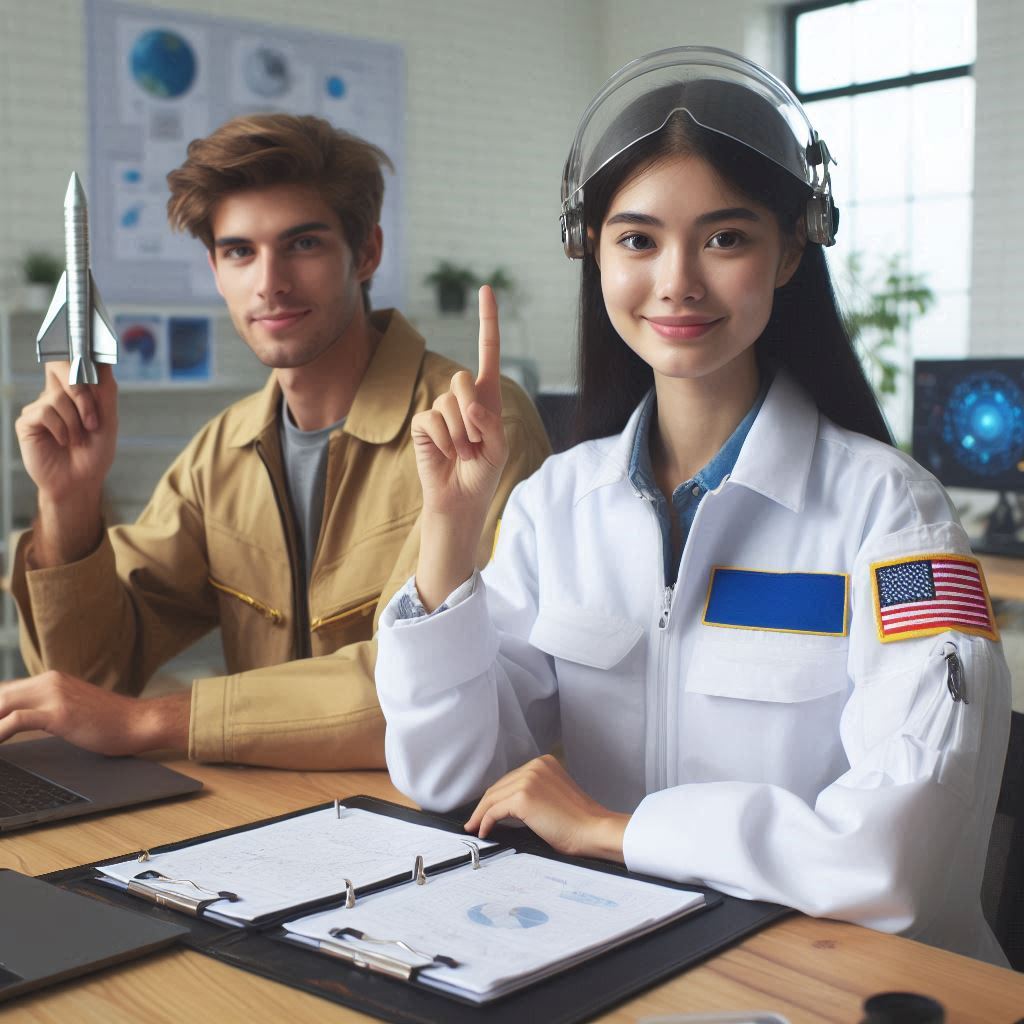Introduction
Aerospace engineering is rapidly gaining popularity as a career choice, thanks to advancements in technology and increased interest in space exploration and aviation innovation.
More people are now considering this exciting field, drawn by the promise of working on cutting-edge projects that push the boundaries of human capability.
Transitioning to aerospace engineering from another field can offer numerous benefits.
It provides an opportunity to apply existing skills in new and innovative ways, engage in high-impact projects, and be part of a dynamic industry with significant growth potential.
Whether you’re coming from a background in mechanical engineering, computer science, or another technical discipline, the move to aerospace engineering can open up a world of possibilities.
We‘ll cover essential topics such as evaluating your current skills, acquiring necessary qualifications, gaining relevant experience, and navigating the job market.
By the end of this guide, you’ll have a clear roadmap to help you embark on your new career path in aerospace engineering.
Assess Your Skills and Interests
Certainly! Here’s a structured approach to assess your skills and interests for a career in aerospace engineering:
Evaluate Your Current Skills, Knowledge, and Interests
Self-Reflection
- List your strengths and weaknesses.
- Identify subjects and activities you enjoy and excel at.
- Reflect on past projects or experiences that you found particularly engaging.
Relevant Skills for Aerospace Engineering
- Strong foundation in mathematics (calculus, linear algebra, differential equations).
- Proficiency in physics, especially mechanics and thermodynamics.
- Understanding of computer programming and software tools (MATLAB, Python, CAD software).
- Analytical and problem-solving skills.
- Attention to detail and precision.
- Strong communication and teamwork abilities.
Research the Specific Skills and Qualifications Required for Aerospace Engineering
Educational Requirements
- Bachelor‘s degree in aerospace engineering or a related field (mechanical engineering, electrical engineering).
- Advanced degrees (Master’s, PhD) for specialized roles and research positions.
Technical Skills
- Knowledge of aerodynamics, propulsion systems, avionics, and materials science.
- Familiarity with industry standards and regulations (FAA, EASA).
- Experience with simulation and modeling software.
Professional Skills
- Project management and organizational skills.
- Ability to work under pressure and meet deadlines.
- Continuous learning to keep up with technological advancements.
Consider Taking Online Assessments or Career Quizzes
Aptitude Tests
- Engineering aptitude tests (FE Exam preparation tests).
- Technical skill assessments in math and physics.
Career Quizzes
- Online career assessments like the Myers-Briggs Type Indicator (MBTI), Strong Interest Inventory, or Holland Code (RIASEC).
- Engineering-specific quizzes (e.g., which engineering discipline is right for you?).
Skill Gap Analysis
- Identify areas where you need improvement or additional knowledge.
- Develop a plan to acquire the necessary skills (online courses, workshops, certifications).
Assessing your fit for aerospace engineering involves a combination of introspection, research, and practical experiences. This will help you make an informed decision about pursuing a career in this field.
Identify Transferable Skills
Identifying Transferable Skills for Aerospace Engineering
When transitioning to aerospace engineering from another field, it‘s important to recognize and highlight the skills and experiences that are relevant and can be transferred. Here are some steps and examples to help you identify and present your transferable skills:
Identify Relevant Technical Skills
- Mathematics and Physics Knowledge: Aerospace engineering heavily relies on math and physics. If you have a background in these areas, this is a key transferable skill.
- Computer Programming: Experience in programming languages such as Python, MATLAB, C++, or software like CAD (Computer-Aided Design) tools are highly relevant.
- Project Management: Experience managing technical projects can be a significant asset.
- Technical Writing: The ability to write clear and concise technical reports is valuable.
Highlight Relevant Projects, Certifications, and Accomplishments
- Projects: Describe any projects you have worked on that involved designing, testing, or problem-solving in engineering contexts.Example: “Developed a simulation model using MATLAB to optimize the design of a mechanical system, reducing error rates by 20%.”
- Certifications: List any relevant certifications such as PMP (Project Management Professional), Six Sigma, or specific aerospace engineering courses.Example: “Completed a certification in Aerospace Structures and Materials from [Institution].”
- Accomplishments: Mention specific achievements that demonstrate your technical abilities.Example: “Led a team to design and implement a control system that improved efficiency by 15%.”
Emphasize Soft Skills
- Problem-Solving: Aerospace engineering requires innovative solutions to complex problems.Example: “Proven track record of troubleshooting and resolving critical system issues under tight deadlines.”
- Creativity: The ability to think outside the box is essential in designing new aerospace technologies.Example: “Developed a novel approach to enhance aerodynamic efficiency, resulting in a 10% improvement.”
- Teamwork: Collaboration is key in aerospace projects which often involve multidisciplinary teams.Example: “Successfully coordinated with cross-functional teams to deliver projects on time and within budget.”
- Communication: The ability to convey complex information clearly to non-technical stakeholders.Example: “Presented technical project updates to senior management, resulting in securing additional project funding.”
Research Education and Training Requirements
Researching Education and Training Requirements for Aerospace Engineering
When pursuing a career in aerospace engineering, it‘s essential to understand the educational and training requirements. Here‘s a comprehensive guide to help you get started:
Bachelor’s Degree
- Primary Requirement: A bachelor’s degree in aerospace engineering or a related field such as mechanical engineering, electrical engineering, or materials science is typically required.
- Coursework: Key subjects include fluid dynamics, materials science, structural analysis, propulsion, aerodynamics, and control systems.
- Top Institutions: Examples include MIT, Stanford University, California Institute of Technology, University of Michigan, and Georgia Tech.
Master’s Degree
- Advancement: A master’s degree can provide specialized knowledge and improve job prospects. It’s often necessary for higher-level positions and research roles.
- Focus Areas: Advanced propulsion systems, aerospace materials, avionics, computational fluid dynamics, and space systems.
Doctoral Degree (PhD)
- Research Focus: For careers in academia or high-level research positions, a PhD is usually required.
- Specialization: Deep specialization in a particular area of aerospace engineering.
Certifications and Training Options
Professional Engineer (PE) License
- Requirement: To advance in certain positions, a PE license is required. It typically involves passing the Fundamentals of Engineering (FE) exam, gaining relevant work experience, and passing the PE exam.
- Certifying Bodies: National Council of Examiners for Engineering and Surveying (NCEES) in the USA.
Certifications
- Six Sigma Certification: Beneficial for roles involving process improvement and quality assurance.
- Project Management Professional (PMP): Useful for roles that involve project management.
- Certified Aerospace Technician: Offered by the Aerospace Technician Training Program for practical skills in manufacturing and maintenance.
Training Programs
- Internships and Co-op Programs: These provide practical, hands-on experience and are often offered by aerospace companies.
- Research Assistantships: Available during undergraduate and graduate studies, providing experience in academic research.
Online Courses and Workshops
Online Degree Programs
- Institutions: Many universities offer online programs in aerospace engineering or related fields.
- Example: Embry-Riddle Aeronautical University offers online degrees in aerospace engineering.
MOOCs (Massive Open Online Courses)
- Platforms: Coursera, edX, Udacity, and Khan Academy offer courses from top universities.
- Example: “Introduction to Aeronautical Engineering” on edX by Delft University of Technology.
- Example: “Aircraft Design: From Concept to Prototype” on Coursera by Stanford University.
Workshops and Short Courses
- Organizations: The American Institute of Aeronautics and Astronautics (AIAA) and the Society of Automotive Engineers (SAE) offer workshops and professional development courses.
- Example: AIAA‘s online courses on topics like “Space Systems Engineering” and “Advanced Propulsion Systems.”
Read: How to Become a Civil Rights Advocate
Networking with Industry Professionals
Transitioning to aerospace engineering from another field Networking with Industry Professionals in Aerospace Engineering
Networking is crucial in establishing a successful career in aerospace engineering. Here‘s how to effectively connect with industry professionals:
Attend Conferences, Workshops, and Networking Events
Conferences
- Key Conferences: Participate in major aerospace engineering conferences to meet industry leaders and stay updated on the latest trends and technologies.
- AIAA SciTech Forum: One of the largest events covering various aspects of aerospace engineering.
- International Astronautical Congress (IAC): A global event bringing together professionals from space agencies, industry, and academia.
- Farnborough International Airshow: Combines a major trade show with networking opportunities.
Workshops
- Professional Organizations: Many organizations offer workshops focusing on specific areas of aerospace engineering.
- AIAA Workshops: Topics include propulsion, materials, and flight mechanics.
- SAE International Workshops: Focus on automotive and aerospace engineering technologies.
Networking Events
- Meetups and Local Events: Join local engineering meetups or events hosted by professional organizations.
- Local AIAA section: Attend events organized by local section of AIAA.
- University Alumni Events: Engage in events hosted by your university‘s alumni network.
Connect with Alumni and Professionals on LinkedIn
Building Your LinkedIn Profile
- Professional Profile: Ensure your LinkedIn profile is complete, highlighting your education, skills, and experiences in aerospace engineering.
- Networking: Connect with professionals in the aerospace industry, including alumni from your university.
Engaging with Connections
- Join Groups: Participate in LinkedIn groups related to aerospace engineering.
- Example: ‘Aerospace Engineering Network‘ and ‘Aerospace Professionals.‘
- Engage with Content: Like, comment, and share relevant content to increase visibility and engagement with your network.
Reaching Out for Advice
- Personalized Messages: Send personalized connection requests and follow up with messages requesting advice or insights.
- Example: ‘Hello [Name], I‘m a recent graduate in mechanical engineering with a keen interest in transitioning to aerospace engineering.
Seek Informational Interviews
Identifying Professionals
- LinkedIn and Alumni Networks: Identify potential contacts through LinkedIn or your university‘s alumni network.
Requesting Informational Interviews
- Polite Requests: Politely ask for a short meeting to discuss their career and the industry.
- Example: ‘Dear [Name], I am exploring career opportunities in aerospace engineering and would greatly appreciate the opportunity to learn about your experiences.
By actively networking, you can gain valuable insights, build meaningful connections, and enhance your career prospects in the aerospace engineering industry.
Read: The Intersection: Architecture & Tech in Modern USA.
Gaining Practical Experience
Practical experience is crucial in developing the skills and knowledge required for a career in aerospace engineering. Here are several strategies to help you gain hands-on experience:
Internships and Co-op Opportunities
Finding Internships
- University Career Services: Utilize your university‘s career services to find internship opportunities.
- Job Boards: Check job boards specific to engineering and aerospace, such as Indeed, Glassdoor, and specialized sites like EngineerJobs and Aeroindustryjobs.
- Company Websites: Visit the career sections of major aerospace companies like Boeing, Lockheed Martin, Northrop Grumman, and SpaceX.
Co-op Programs
- University Programs: Many universities offer co-op programs that allow you to alternate between semesters of study and full-time work.
- Application Process: Apply through your university‘s co-op office or directly with participating companies.
Examples of Companies Offering Internships/Co-ops
- NASA Internships: Offers various internships for students and recent graduates.
- Boeing Internships: Opportunities in engineering, manufacturing, and IT.
- Lockheed Martin Co-op Programs: Available for students in engineering, business, and related fields.
Volunteering for Engineering Projects or Research Initiatives
University Projects
- Capstone Projects: Participate in capstone projects, which often involve real-world aerospace engineering challenges.
- Research Labs: Volunteer in aerospace or engineering research labs at your university.
Community Projects
- STEM Outreach: Volunteer for STEM outreach programs to work on engineering projects with local schools or community organizations.
- Non-Profit Organizations: Organizations like Engineers Without Borders often have engineering projects that require volunteers.
Online Platforms
- Crowdsourcing Projects: Participate in crowdsourced engineering projects on platforms like GrabCAD and Kaggle.
Joining Engineering Clubs or Organizations
University Clubs
- Aerospace Engineering Clubs: Join clubs specific to aerospace engineering to work on team projects, participate in competitions, and attend guest lectures.
- Example: American Institute of Aeronautics and Astronautics (AIAA) student sections.
- Multidisciplinary Clubs: Clubs like the Society of Automotive Engineers (SAE) or robotics clubs also offer relevant experience.
Professional Organizations
- AIAA: Offers networking opportunities, conferences, and technical resources.
- SAE International: Provides access to industry events, technical papers, and standards.
- Women in Aerospace: Focuses on supporting women in the aerospace field through networking, mentoring, and development opportunities.
Competitions and Events
- Design Competitions: Participate in aerospace-related design competitions such as the AIAA Design/Build/Fly competition or NASA‘s Student Launch Initiative.
- Hackathons and Engineering Challenges: Events that provide practical experience in solving real-world engineering problems.
By actively seeking these opportunities, you can develop practical skills, expand your network, and enhance your qualifications for a successful career in aerospace engineering.
Read: Economic Indicators and Their Influence on US Architects
Update Your Resume and Cover Letter
When applying for positions in aerospace engineering, it‘s crucial to tailor your resume and cover letter to highlight your transferable skills, relevant experiences, and passion for the field.
Here‘s a guide to help you craft compelling application materials:
Customizing Your Resume
Contact Information
- Include your full name, phone number, email address, and LinkedIn profile.
Professional Summary
- Write a brief summary that highlights your relevant skills, experiences, and career goals in aerospace engineering.
- Example: ‘Innovative and results-driven mechanical engineer with a strong background in computational fluid dynamics and structural analysis.
Education
- List your degrees, institutions, graduation dates, and relevant coursework.
- Example: ‘Bachelor of Science in Mechanical Engineering, Harvard University, May 2022. Relevant coursework: Aerodynamics, Propulsion Systems, Aircraft Design, Structural Mechanics.‘
Tailoring Your Cover Letter
Header
- Include your contact information, the date, and the recipient‘s contact information.
Introduction
- Start with a strong opening that mentions the position you‘re applying for and how you learned about it.
- Example: With a Bachelor‘s degree in Mechanical Engineering and hands-on experience in aerodynamics and structural analysis, I am eager to contribute to your innovative projects.‘
Body
- Highlight your relevant experiences, skills, and achievements. Provide specific examples that demonstrate your qualifications.
- Emphasize your passion for aerospace engineering and the company‘s mission.
By following these steps, you can create a resume and cover letter that effectively showcase your qualifications and enthusiasm for a career in aerospace engineering.
Read: Post-Pandemic Design Trends: US Architects Adapt

Prepare for Interviews
Interview preparation is key to making a strong impression and securing a position in aerospace engineering. Here‘s a comprehensive guide to help you get ready for your interviews:
Practice Common Interview Questions
Technical Questions
- Fundamentals:“Explain the principles of aerodynamics.””What are the key factors in designing a propulsion system?”
- Problem-Solving:“How would you approach designing a new wing for an aircraft?””Describe a challenging technical problem you faced and how you solved it.”
- Software Proficiency:“What experience do you have with CAD software like SolidWorks or CATIA?””How have you used MATLAB/Simulink in your previous projects?”
Behavioral Questions
- Teamwork and Collaboration:“Can you describe a time when you worked on a team project and faced a conflict? How did you handle it?””How do you approach collaborating with cross-functional teams?”
- Project Management:“Tell me about a project where you had to manage multiple deadlines. How did you ensure everything was completed on time?””How do you prioritize tasks when working on multiple projects?”
- Adaptability and Learning:“Describe a situation where you had to quickly learn a new skill or technology. How did you approach it?””How do you stay updated with the latest developments in aerospace engineering?”
Personal Motivation
- Career Goals:“Why did you choose a career in aerospace engineering?””Where do you see yourself in five years?”
- Passion for the Field:“What excites you the most about working in aerospace engineering?””Can you share a specific project or experience that fueled your interest in aerospace?”
Research the Company and Industry Trends
Company Research
- Company Background:Study the company‘s history, mission, and values.Understand the company‘s key projects, products, and services.
- Recent News:Look for recent news articles or press releases about the company.Identify any recent achievements, partnerships, or new projects.
- Company Culture:Read employee reviews on sites like Glassdoor to understand the company culture.Look for information on the company‘s work environment and values.
Industry Trends
- Current Trends:Stay updated on the latest trends and developments in aerospace engineering, such as advancements in materials science, propulsion systems, and avionics.
- Technological Innovations:Research emerging technologies like electric propulsion, autonomous flight systems, and space exploration initiatives.
- Regulatory Environment:Understand the regulatory landscape affecting the aerospace industry, including safety standards and environmental regulations.
Showcase Your Passion and Commitment
Express Enthusiasm
- Personal Stories:Share personal stories or experiences that highlight your passion for aerospace engineering.Explain why you are excited about the specific role and company.
- Relevant Projects:Discuss specific projects or coursework that demonstrate your interest and dedication to aerospace engineering.
- Continuous Learning:Mention any efforts you have made to learn more about the field, such as attending workshops, taking online courses, or participating in relevant clubs and organizations.
Commitment to Transitioning
- Transferable Skills:Highlight how your existing skills and experiences are relevant to the aerospace industry.
- Professional Development:Discuss any steps you have taken to prepare for a career in aerospace engineering, such as obtaining certifications or participating in internships.
- Long-Term Goals:Outline your long-term career goals and how this position aligns with your aspirations in aerospace engineering.
You Might Also Like: Career Growth Opportunities in Environmental Engineering
Conclusion
Next, research the educational and training requirements for aerospace engineering.
Investigate degree programs, certifications, and additional training options that will equip you with the necessary knowledge and skills.
Consider enrolling in online courses or workshops to bridge any gaps and enhance your qualifications.
Networking plays a crucial role in this transition.
Attend industry conferences, workshops, and networking events to connect with aerospace professionals and learn about the latest trends and opportunities in the field.
Utilize LinkedIn to connect with alumni and industry experts for advice and mentorship, and seek out informational interviews to gain insights into the industry.
Updating your resume and cover letter is crucial for making a strong impression.
Tailor these documents to highlight your relevant skills, experiences, and passion for aerospace engineering.
Include any pertinent coursework, certifications, or extracurricular activities that align with the field.
Practice answering common aerospace engineering questions, research the company and industry trends, and showcase your enthusiasm for the field.
Transform Your Career Today
Unlock a personalized career strategy that drives real results. Get tailored advice and a roadmap designed just for you.
Start Now



